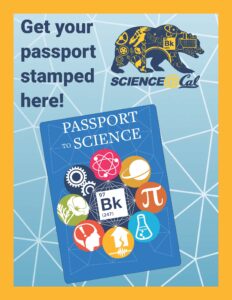This content has been archived. It may no longer be relevant
Join us for Cal Day, Sat urday, April 16th, from 12pm-5pm, the one day each year that UC Berkeley’s Space Sciences Lab opens its doors to the public. Shuttles will be transporting the public every 15 minutes from Hearst Mining Circle on campus to SSL. Activities include walking tours of UC Berkeley’s cutting-edge space science research lab, tech talks and general talks, a career panel on cool jobs in space science, and hands-on activities for all ages! Below is a list of our planned activities.
urday, April 16th, from 12pm-5pm, the one day each year that UC Berkeley’s Space Sciences Lab opens its doors to the public. Shuttles will be transporting the public every 15 minutes from Hearst Mining Circle on campus to SSL. Activities include walking tours of UC Berkeley’s cutting-edge space science research lab, tech talks and general talks, a career panel on cool jobs in space science, and hands-on activities for all ages! Below is a list of our planned activities.
Walking Tours (12:00 pm – 4:20 pm) See UC Berkeley’s cutting-edge space science research lab. Learn about the illustrious NASA missions, current and past, that Space Sciences had a hand in, visit our 60′ high bay, the cosmochemistry laboratories that analyzed lunar samples, a clean room where a Hubble instrument was built. Tours start at 12 am and leave every 20 minutes to 4:20pm. Last tour 4:20 p.m.
 Adventures in Space Sciences Passports to Science@Cal
Adventures in Space Sciences Passports to Science@Cal
Learn about UV rays, make an origami Sun, play Solar Jeopardy, design your own planet to be loaded on the Magic Planet, look through a solar telescope. Many activities are specifically for children ages 6-12. Explore the world of science with your Passport to Science@Cal! At each of your destinations, your passport will get a fun stamp or sticker to show where your travels have taken you.
TECH TALKS – ADVANCED, HIGH LEVEL CONTENT
12:00 pm – 1:00 pm Imaging With Neutrons: Can You See a Flower Through a Granite Wall? – Dr. Anton Tremsin CANCELLED
Neutron detection technology developed for NASA astrophysical missions at Space Sciences Laboratory can reveal processes happening inside and behind thick objects–where an organic object is opaque and many metals can be easily penetrated. New data from these non-destructive studies will be presented.
1:00 pm – 02:00 pm NASA’s ICON Mission – Dr. Scott England
Berkeley’s newest space mission, the Ionospheric Connection Explorer (ICON) will explore the boundary region between Earth and space where ionized plasma collides and reacts with our atmosphere. Come learn more about this exciting mission set to launch in 2017.
2:00 pm – 3:00 pm Missions OperatioMAVENns Center and Satellite Dish – Dr. Manfred Bester NEW: Bryce Roberts
The Berkeley MOC serves as the satellite-control and data archiving facility for a number of different NASA missions and was designed to support multiple spacecraft operations. Hear about the science behind these missions and the history of our 36′ satellite-tracking antenna dish.
ONGOING – Silver Lobby – From Lab to Launchpad – Chris Scholz
Come see a slideshow of Berkeley’s NASA missions as they are built, tested, shipped and prepared for launch. Featured is MAVEN, our latest mission to Mars. (will not be there from 1-2pm)
GENERAL TALKS / PANELS – INFORMATIONAL FOR ALL
12:00 pm – 1:00 pm Report about LIGO and Gravitational Waves – Dr. Harald Frey
Reports about the first measurement of gravitational waves made news headlines in February of this year. The main points of the General Theory of Relativity and Gravitational Waves will be explained to a general audience together with a discussion of the importance and implications of these very first measurements.
1:00 pm – 2:00 pm Cool Careers in Space Science – panel discussion
Join a one-hour round table discussion at the Space Sciences Laboratory to hear students, scientists, and others share the varied paths they have taken to arrive at working in space science careers. Moderater: Ruth Paglierani, Panelists: Dr. Darcy Barron, Nicole Duncan, Dr. Matt Fillingim, & Chris Scholz
2:00 pm – 3:00 pm Red Planet Facts – All about Mars – Dr. Matt Fillingim
Think you know all about our neighboring planet? This family-friendly talk will explain what makes Mars so interesting and how Berkeley was involved in NASA’s recent mission MAVEN.
3:00 pm – 4:00 pm Cultural Expressions of the Sun – Dr. Bryan Mendez
The Sun has a powerful influence over life on Earth and is incorporated deeply into every human culture in both obvious and subtle ways. This family-friendly presentation will examine how peoples around the world and throughout time have expressed their ideas about the Sun in everything from agriculture, art, and literature to architecture, religion, and science.
4:00 pm – 5:00 pm Antarctica and Space! – Dr. Kees Welten, Nicole Duncan
What can the coldest place on Earth tell us about space science? A lot, actually! From ice-core samples that tell us about the ancient Sun, to recent balloon missions that just launched. Come hear about how Berkeley missions has ties to the South Pole.
Visit Our Neighbor: Lawrence Hall of Science
See how the Hall is inspiring the next generation of scientists, engineers, and designers. Have your Science@Cal passport stamped as you explore the wonderful world of science. Join free Planetarium presentations, design your own nano creations, and explore real-time datasets on Science On a Sphere. For more information, visit the Hall’s Cal Day page [link to: http://www.lawrencehallofscience.org/visit/events/cal_day_at_the_hall]

